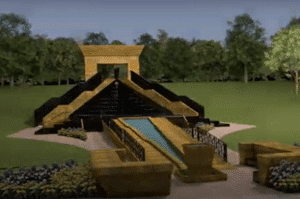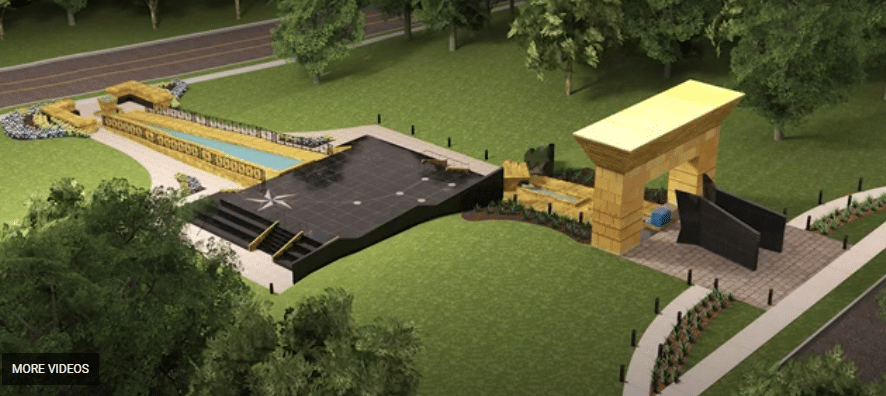By Sarai Murdock
Cleveland is known for its iconic landmarks, including the Rock and Roll Hall of Fame, The Cleveland Museum of Art, and The Cleveland Orchestra at Severance Hall. However, one hidden gem that often goes overlooked is the African American Cultural Garden (AACG).
The AACG is a garden and monument that represents the journey and history of African American slaves. The garden was dedicated in 1977 but never fully completed. The Association of African American Cultural Garden (AAACG) intends to finish this garden and maintain its beauty and history. It also plans to host more events that spread knowledge of African American history and allow people to celebrate its culture. The question? Is this what Cleveland needs to both save our neighborhoods and bring more education and acceptance of diverse cultures?

The monument expresses aspects of the Trans-Atlantic Slave Trade through an interpretation of the dungeons and “Doorway of No Return” of the slave castles located on the West Coast of Africa. Moving more into the segment, people can reach what is named the “Corridor of No Return,” which are polished black walls representing the tension of slaves traveling in tight spaces not knowing where they are heading. You can go to their website, https://www.aaacg.org/meaning, to learn more about what each section of the AAACG represents.
The monument expresses aspects of the Trans-Atlantic Slave Trade through an interpretation of the dungeons and “Doorway of No Return” of the slave castles located on the West Coast of Africa. Moving more into the segment, people can reach what is named the “Corridor of No Return,” which are polished black walls representing the tension of slaves traveling in tight spaces not knowing where they are heading.
Cleveland is a place for diverse groups of members to find their place in the community. But what exactly goes into “diversity”? 18-year-old human rights activist Anaya Harvey talks a bit about how she sees diversity in Cleveland in an interview.
“I worked with the city architect here and when it came to understanding what diversity was we looked at the tax market and we looked at race and we looked at things like sexuality and in reality, Cleveland is a place that is predominately people of color because of things like redlining. So you have inner-city Cleveland, you have places like Shaker Heights or South Euclid or Cleveland Heights even, and in those spaces, inner-city Cleveland is a place that is redlining the only good space for quote on quote the ‘poor people’ and that’s deemed because of how society has put us and placed us.”
Cleveland is one of the top cities in the US deemed most unsafe. Forty-year-old Chris Harris talked about his experience growing up as a young African American in Cleveland.
“I moved around a lot. Personally because of my mother and my father not getting along. Death threats between my family and stuff like that. Drug abuse, things like that.”
He also talked about the violence when he was young versus what it’s like now.
“People were trying to buy drugs or get drugs so they were robbing people that were selling it and if they didn’t get what they wanted they were killing them and stuff. But now it’s like it’s just senseless shooting and killing for no reason.”
Twenty-six -year-old Maya Shaw added to the discussion of violence when she talked about her experience at a 2020 protest for the death of George Floyd.
“That protest was very traumatizing. It was like they treated us literally like animals,” she says. “I even saw a person, a black man, literally right in front of me get shot with something.” She also described how police brought multiple school buses to arrest protesters, saying, “I haven’t been to a protest since then because that one really traumatized me.”
Maya Shaw’s grandmother, Ada Mae Wade, moved from Americus, Georgia to Cleveland during the great migration at the young age of 20 years old. She was a grassroots organizer in Glenville/Shaw in the 1970s and continued her work through the 80s.
“This cultural garden is very important to me in the sense that my grandmother felt very, very, very strongly about East Cleveland. She lived and died there, once she migrated there, and she got involved in politics to help black people get registered to vote in East Cleveland and she did everything that she could to really keep things going forward,” Shaw said.
When asked about the importance of having diverse spaces to learn about black culture and history this is what 40-year-old fashion designer/model Alicia Sanderson had to say.
“Because I think if they really see the talent and drive that people have I think it will make people come together as a collective, they’ll stop going against each other. It will be more teamwork which will create bigger dreams. People won’t be so competitive against each other. It will probably make them bond and work together. If people have something else to focus on just maybe it will help take some of the focus off the negativity in the streets.”
CSU student Naron Goggans also looks forward to what the AAACG is bringing to the black community in Cleveland.
“It will be someplace I can probably go to learn more about and see, and one day just look and calm my mind and just see what I’m fighting for. And I always think that I have much to do and much to learn and I won’t be here where I’m at without my ancestors.”
The AACG allows people to learn about their history interactively while also enjoying the beautiful scenery of nature. It can be found in the Rockefeller Park & Greenhouse located on MLK Jr Drive.
You can go to their website,The Association of African American Cultural Gardens meaning, to learn more about what each section of the AAACG represents.




